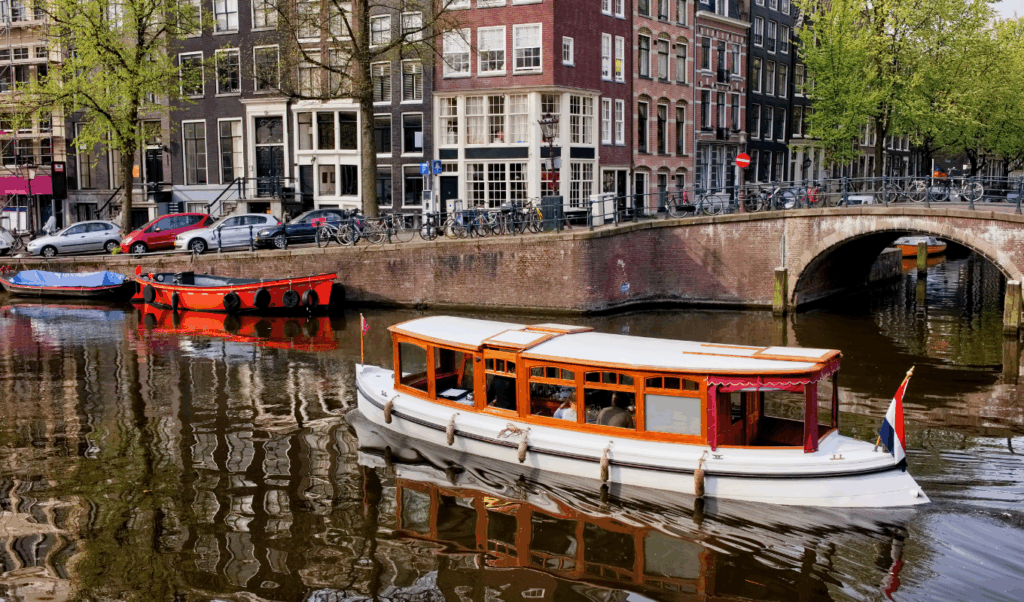Amsterdam is one of the easiest European cities to visit, combining convenience with rich experiences. Here’s why it’s a top pick for travelers:
- Affordable Flights: Deals as low as $289 from the U.S. make it budget-friendly.
- Easy Navigation: Compact layout with trams, bikes, and walkable streets.
- Top Attractions: Must-sees include the Rijksmuseum, Van Gogh Museum, and Anne Frank House.
- Cashless Payments: Credit cards are widely accepted – no need to carry much cash.
- Weather Prep: Pack layers and waterproof gear for unpredictable weather.
Plan ahead by booking flights early, reserving tickets for key attractions, and using tools like the I amsterdam City Card for savings on transport and entry fees.

Planning Your Amsterdam Trip
Starting your Amsterdam adventure begins with some thoughtful preparation. Finding affordable flights and understanding the essentials of international travel can make all the difference in ensuring a smooth trip. Let’s dive into how you can save on flights and get ready for your journey.
How to Find Cheap Flights
Scoring affordable flights to Amsterdam is all about timing, flexibility, and using the right tools. Booking your tickets 2-4 months in advance is often the sweet spot for snagging the best deals. During the low season, round-trip fares typically range from $450-$600, while peak summer months can push prices to $700-$900 or more.
Flight alert services can be a game-changer. Platforms like Dollar Flight Club notify you of price drops, helping you grab discounted fares to destinations like Amsterdam.
Being flexible with your travel dates can also lead to significant savings. Mid-week departures and trips during shoulder seasons, such as late fall or early spring, tend to offer the lowest fares. On the flip side, traveling during summer (June through August) or major holidays often means higher prices due to increased demand.
When comparing fares, it’s worth checking both US dollar and euro pricing. While booking in US dollars can help you avoid foreign transaction fees if your credit card charges them, sometimes European airlines offer lower fares in euros. Just be sure to account for any additional fees to get the full picture of your costs.
Once your flight is locked in, it’s time to focus on the practical details of your trip.
What to Know Before You Travel
For US citizens, travel documentation is straightforward. You’ll need a valid passport with at least six months of validity beyond your return date. No visa is required for stays under 90 days, as the Netherlands is part of the Schengen Area.
Amsterdam Schiphol Airport is one of Europe’s busiest, serving over 70 million passengers annually. Known for its efficiency and clear English signage, the airport makes navigating international arrivals easier. Beneath the terminal, you’ll find a train station offering quick connections to Amsterdam Centraal. Keep in mind that European flights often include additional charges like passenger service fees and local taxes, which can add $30-$60 or more to your fare. To avoid delays, plan to arrive at Schiphol 2–3 hours before your flight during busy periods.
Travel insurance is another important consideration. It can cover medical emergencies, trip cancellations, and lost luggage – offering peace of mind while you’re abroad. Also, check your credit card’s foreign transaction policies before leaving. Cards that waive foreign transaction fees can save you 2-3% on purchases made in euros.
Finally, think about time zone adjustments to help combat jet lag. Amsterdam operates on Central European Time, which is 6 hours ahead of Eastern Standard Time. Gradually shifting your sleep schedule before departure can make the adjustment easier once you arrive.

Getting Around Amsterdam
With your trip planned and flights booked, it’s time to figure out how to navigate Amsterdam. This lively city offers three main ways to get around: public transportation, biking, and walking. Each option has its own charm, and many visitors find that mixing these methods is the best way to explore Amsterdam’s compact, canal-lined streets.
Using Public Transportation
Amsterdam’s public transportation system, operated by GVB, includes trams, buses, metros, and ferries that connect key parts of the city. Trams are especially convenient, running frequently through the city center and stopping near popular spots like Museumplein, Central Station, and the Jordaan district.
Paying for transit is straightforward with the OVpay system. Instead of buying separate tickets or cards, you can simply tap your contactless credit card or mobile wallet when boarding. A single ride costs about €3.40 (roughly $3.70 USD), but if you plan to travel extensively, a 24-hour pass for €9.00 (about $9.80 USD) is a better deal. For those planning to visit multiple attractions, the Iamsterdam City Card offers unlimited public transport along with free or discounted entry to various landmarks.
Most ticket machines and kiosks accept major US credit cards like Visa and Mastercard. However, some may require a chip and PIN, so it’s a good idea to check with your bank about any international fees beforehand. If you’re headed to Amsterdam-Noord, free ferries cross the IJ River, providing easy access to highlights like the A’DAM Lookout Tower and its stunning views of the city.
Renting and Riding Bikes
Cycling is practically a way of life in Amsterdam, with more bikes than residents – over 880,000, to be exact. Renting a bike is a great way to experience the city like a local. Shops such as MacBike, Yellow Bike, and Black Bikes are conveniently located throughout Amsterdam, with daily rentals typically costing between €10 and €15 (about $11–$16 USD).
Most bike rental shops accept US credit cards and require a valid ID, along with a deposit or a credit card hold. Bike insurance is worth considering, as theft and heavy traffic are common concerns.
When cycling, stick to designated bike lanes, obey traffic signals, and yield to pedestrians. Using hand signals for turns and avoiding distractions like your phone will help ensure a safer ride. While helmets aren’t required in the Netherlands, they’re a good idea if you’re not used to biking in a busy urban setting. Also, remember that trams always have the right of way, so be extra cautious at intersections. Lastly, always lock your bike securely when leaving it unattended.
Walking Around the City
Amsterdam’s compact layout makes it a joy to explore on foot. The flat terrain and pedestrian-friendly streets are perfect for wandering through neighborhoods like Jordaan, De 9 Straatjes (Nine Streets), or even the Red Light District at your own pace. Comfortable walking shoes are a must, as you’ll likely cover several miles each day. Be mindful that some historic sidewalks can be narrow or uneven, and they’re often shared with cyclists.
Navigation apps like Google Maps or Citymapper are great for real-time directions, while offline apps like Maps.me can help you save on mobile data.
Walking allows you to uncover hidden gems, from tucked-away courtyards to cozy cafés, while soaking in the city’s iconic canal-side architecture. For a particularly magical experience, take a stroll in the early morning or late afternoon when the light reflects beautifully off the water and the streets are less crowded.

Top Attractions and Activities
Amsterdam is a city that effortlessly blends its rich history with modern creativity. From world-class museums to charming neighborhoods, there’s something here for every traveler – whether you’re into art, history, or simply soaking up local vibes.
Famous Amsterdam Landmarks
The Rijksmuseum is often considered the crown jewel of Amsterdam. Drawing over 2 million visitors annually, it’s the most popular museum in the Netherlands. Inside, you’ll find an extraordinary collection of Dutch Golden Age masterpieces, including works by Rembrandt and Vermeer. Tickets for adults cost €22.50 (around $24 USD), while visitors 18 and under can enter for free. The museum is open daily from 9:00 AM to 5:00 PM, with last entry 30 minutes before closing.
Not far from the Rijksmuseum, the Van Gogh Museum houses the largest collection of the artist’s works in the world. Tickets cost about $31 (approximately €29) for adults, with prices varying for children. Both the Rijksmuseum and the Van Gogh Museum require advance online reservations, especially during high travel seasons when time slots fill up quickly.
For a deeply moving experience, visit the Anne Frank House, which provides a poignant look into Anne Frank’s life and World War II history. Tickets are only available online, often released weeks ahead, so planning ahead is essential. This visit is widely regarded as a must for anyone wanting to understand Amsterdam’s wartime history.
Amsterdam’s canal belt, recognized as a UNESCO World Heritage site, is best explored by boat. Canal cruises are a relaxing way to admire the city’s historic architecture and charming bridges. Cruises depart frequently near Central Station, with tickets typically ranging from €15 to €25 (around $16 to $27 USD), depending on the operator and type of cruise.
For breathtaking views of the city, head to the A’DAM Lookout in Amsterdam Noord. Admission for adults is €16.50 (about $18 USD), while children’s tickets are €10.50 (around $11.50 USD). Feeling adventurous? Add €5 for a ride on the rooftop swing, which extends over the edge of the tower for an unforgettable thrill.
To make the most of your time, consider visiting popular attractions early in the morning before crowds build up. Beyond these iconic landmarks, Amsterdam’s neighborhoods offer a chance to experience the city’s everyday charm.
Local Neighborhoods Worth Visiting
Amsterdam’s neighborhoods are where the city’s character truly comes to life. Jordaan is a picturesque area with cobblestone streets, independent boutiques, and cozy cafés. Once a working-class district, it’s now one of the city’s most sought-after neighborhoods, known for its weekend markets and intimate dining spots nestled in historic buildings.
For food lovers, De Pijp is a must-visit. Anchored by the bustling Albert Cuyp Market, this neighborhood showcases Amsterdam’s international flavor with a mix of traditional Dutch eateries and inventive fusion restaurants. In the evenings, the area comes alive as locals gather on terraces and the streets buzz with lively conversations.
Over in Amsterdam Noord, the NDSM Wharf stands out as a hub for creativity. This former shipyard has been transformed into a cultural hotspot, featuring vibrant street art, festivals, and unique creative spaces. While exploring the area is free, the STRAAT Museum, located at NDSM, charges €17.50 (about $19 USD) for adults and €8.50 for teens aged 13-18. Kids under 12 can enter for free. The mix of industrial heritage and modern art makes this a standout destination for those looking for something out of the ordinary.
If you’re into contemporary art, newer attractions like Fabrique des Lumières in Westerpark and the Nxt Museum in Amsterdam Noord offer immersive digital art experiences. Another favorite is De Hallen Amsterdam in Oud-West, a repurposed tram depot that now houses food halls, artisan shops, and a cinema – a perfect spot for both locals and visitors.
For those planning to visit several attractions, the Iamsterdam City Card can help you save on entry fees and public transit. Whether you’re exploring iconic landmarks or diving into the charm of local neighborhoods, Amsterdam offers a well-rounded experience.
| Attraction | Adult Price | Child Price | Booking Notes |
|---|---|---|---|
| Rijksmuseum | €22.50 (~$24) | Free (under 18) | Book online in advance |
| Van Gogh Museum | $31 (~€29) | Varies by age | Timed entry required |
| A’DAM Lookout | €16.50 (~$18) | €10.50 (~$11.50) | +€5 for rooftop swing |
| STRAAT Museum | €17.50 (~$19) | €8.50 (13-18), Free <12 | Located at NDSM Wharf |
| Canal Cruise | €15–€25 (~$16–$27) | Varies by operator | Multiple departure points |
To make the most of your visit, group nearby attractions like those around Museumplein to save time and cut down on travel. Early morning or late afternoon visits can also help you avoid the busiest crowds.

Local Tips and Travel Advice
Exploring Amsterdam like a local means understanding its customs, culture, and a few practical tips. These insights will not only help you enjoy the city more confidently but also avoid common tourist pitfalls. Whether you’re indulging in Dutch treats or navigating the bustling streets, these tips will make your trip smoother and more rewarding.
Food, Drinks, and Markets
Amsterdam’s food scene is packed with flavors that locals love. Start with a warm stroopwafel from a street vendor – it’s a gooey, caramel-filled delight. For cheese lovers, aged Gouda or Edam from specialty shops is a must-try.
Head to Albert Cuypmarkt, a lively street market in De Pijp that’s been around since 1905. Here, you’ll find everything from fresh produce and local snacks to vintage clothes and household goods. It’s also a great place to pick up some basic Dutch phrases while mingling with locals.
For a more modern food experience, check out Foodhallen in Oud-West. This indoor market brings together a variety of culinary options, offering both traditional Dutch dishes and international cuisine under one roof.
Don’t miss Amsterdam’s famous brown cafés – cozy spots with dark wood interiors where locals unwind with a cold pils or a glass of jenever (Dutch gin). And for a taste of Amsterdam’s colonial past, try Indonesian rijsttafel, an elaborate spread of small, flavorful dishes.
As you enjoy these local favorites, remember to stay mindful of safety and etiquette to make the most of your experience.
Local Rules and Safety Tips
Amsterdam’s bike culture is legendary, with over 800,000 bicycles weaving through the city’s streets. Always respect bike lanes and look both ways before crossing – they’re as much a part of the city as the canals.
In busy areas like the Red Light District, be cautious of pickpockets. Keep valuables in front pockets or use a money belt. And remember, taking photos of sex workers is strictly prohibited – it’s considered highly disrespectful.
Cannabis may be tolerated in licensed coffeeshops, but it’s still illegal to consume it elsewhere. Public intoxication or disruptive behavior can lead to fines, so always carry a valid ID. Similarly, drinking alcohol is only allowed in designated public areas, which are marked with signs.
Most businesses in Amsterdam prefer cashless payments, so be ready to use contactless cards or mobile payment apps. When dining out, tipping isn’t obligatory, but rounding up the bill or leaving 5–10% for good service is appreciated.
What to Pack for Amsterdam Weather
Amsterdam’s weather is famously unpredictable, so packing smart is key. Layers and waterproof gear are your best friends. Rain is a frequent visitor, so a compact umbrella and a waterproof jacket are non-negotiable.
| Season | Temperature Range | Essential Items | Weather Notes |
|---|---|---|---|
| Spring | 45–60°F (7–16°C) | Layers, waterproof jacket, umbrella | Frequent rain, tulip season |
| Summer | 60–75°F (16–24°C) | Light layers, rain jacket, comfy shoes | Mild but unpredictable |
| Fall | 45–60°F (7–16°C) | Warm layers, waterproof gear | Shorter days, more rain |
| Winter | 35–45°F (2–7°C) | Heavy coat, waterproof boots, warm accessories | Cold, wet, limited daylight |
Tap water in Amsterdam is perfectly safe to drink, so carrying a reusable water bottle is both practical and eco-friendly. While most locals speak excellent English, learning a few Dutch phrases like “dank je wel” (thank you) and “excuseer me” (excuse me) can go a long way in making your interactions more enjoyable.

Saving Money During Your Visit
With a bit of smart planning, you can enjoy everything Amsterdam has to offer without stretching your budget. From managing daily expenses to taking advantage of discount passes, these tips will help you make the most of your trip without breaking the bank.
Daily Budget Planning
Having a clear idea of your daily spending can keep you on track financially. Costs in Amsterdam largely depend on your travel style:
- Budget travelers can expect to spend around $65–$98 per day. This includes a hostel stay ($33–$55), meals from local markets or casual eateries ($20–$30), and public transportation ($10–$15).
- Mid-range travelers should plan for about $130–$196 per day, covering budget hotel accommodations ($87–$130), restaurant meals, and entrance fees for attractions.
Using a currency conversion app to track expenses in euros and US dollars can be a lifesaver. For instance, a €20 museum ticket is roughly $22. To save even more, consider staying in neighborhoods like De Pijp or Jordaan, where accommodations tend to be more affordable and offer a glimpse of local life. Dining at spots like Albert Cuypmarkt or Foodhallen is often cheaper than eating at restaurants near major tourist sites.
Combining daily budget planning with discount passes can help you stretch your dollars even further.
Discount Cards and Passes
If you’re planning to visit multiple museums or use public transit frequently, discount cards can be a game-changer. Here are some options to consider:
| Pass/Card | Price | Duration | Key Benefits |
|---|---|---|---|
| I amsterdam City Card | $65 | 24 hours | Access to over 70 museums, unlimited transit, a canal cruise, and bike rental |
| I amsterdam City Card | $114 | 72 hours | Same benefits for 3 days |
| GVB Transit Pass | $10 | 24 hours | Unlimited trams, buses, and metro rides |
| GVB Transit Pass | $22 | 72 hours | Unlimited public transport for 3 days |
To put this into perspective, individual museum tickets usually cost between $16 and $27. If you plan to visit three major attractions – like the Rijksmuseum, Van Gogh Museum, and Stedelijk Museum – you’d spend about $75. With the 24-hour I amsterdam City Card, priced at $65, you save money while also getting unlimited public transport and a canal cruise. Similarly, if you’re taking four or more public transit rides in a day, a GVB pass offers better value than buying single tickets. The key is to map out your itinerary in advance to maximize the benefits of these passes.
While managing daily expenses is important, saving on flights can have the biggest impact on your overall budget.
Using Dollar Flight Club for Travel Savings
Flights often account for 40–60% of a trip’s total cost, so finding affordable airfare can make a huge difference. Dollar Flight Club helps travelers snag discounted fares, sometimes up to 90% off the regular price. For example, flights to Amsterdam from the U.S. typically cost $700–$1,000, but with Dollar Flight Club, you might find tickets in the $300–$500 range – saving $400–$700 per person.
The service sends instant alerts via email and SMS for mistake fares and limited-time deals, so you can act fast. Plus, members gain access to over $1,000 in travel perks and discounts from top brands, making it easier to cut costs on other parts of your trip. Those savings can go straight toward enjoying Amsterdam’s museums, canal cruises, or indulging in some local delicacies.

Start Planning Your Amsterdam Trip
Amsterdam is calling, and with a bit of preparation, your visit can be unforgettable without breaking the bank. Start by looking for affordable flights through Dollar Flight Club, a service that’s helped over 3 million travelers snag airfare deals at up to 90% off standard prices. Membership also comes with over $1,000 in travel perks and discounts from major brands. With these tools, you’ll be ready to lock in your travel plans and get your adventure underway.
Reserve tickets for major attractions early – it’s a must, especially during busy seasons. As mentioned in the attractions section, popular spots often sell out quickly, so booking ahead ensures you won’t miss out on your top picks.
Map out your transportation options to make the most of Amsterdam’s bike-friendly streets and efficient public transit system. The I amsterdam City Card is a great investment, offering up to 40% savings on museum admissions and unlimited public transport. It’s a convenient way to explore everything from world-famous landmarks to hidden gems in the city’s neighborhoods.
Once flights and transportation are sorted, make sure your packing list is ready for Amsterdam’s unpredictable weather. Check out the seasonal packing guide above for tips on must-have items to keep you comfortable.
With more than 20 million international visitors flocking to Amsterdam in 2023, you’ll be joining a global community of travelers drawn to its unique mix of history and modern flair. Armed with the advice in this guide, you’ll have everything you need to explore confidently, affordably, and with plenty of excitement.
FAQs
How can I find the best flight deals to Amsterdam?
To snag amazing flight deals to Amsterdam, think about joining Dollar Flight Club. They send out alerts for deeply discounted fares, sometimes saving you as much as 90% on flights. It’s an easy and effective way to find budget-friendly options for trips both within the U.S. and abroad.
How can I get the most out of the I amsterdam City Card during my trip?
The I amsterdam City Card is a smart choice for anyone looking to save money and streamline their trip to Amsterdam. With this card, you get free access to many of the city’s top attractions, unlimited use of public transportation, and exclusive discounts at certain restaurants and shops.
To get the most value out of the card, plan your schedule around the attractions it covers. Highlights include must-sees like the Van Gogh Museum, the Rijksmuseum, and even a canal cruise – a quintessential Amsterdam experience.
Remember, the card’s validity works on consecutive hours (e.g., 24, 48, or 72 hours), so activate it only when you’re ready to start exploring. Use the included public transportation access to navigate the city with ease, and don’t forget to take advantage of the free city map and guide to discover Amsterdam like a seasoned traveler.
What should I pack for Amsterdam’s unpredictable weather?
Amsterdam’s weather likes to keep you on your toes, so packing smart is key. Layering is your best friend here – be ready for both sunshine and unexpected rain. A lightweight, waterproof jacket is a must-have since sudden showers are part of the city’s charm. And don’t skimp on comfortable walking shoes; those cobblestone streets and scenic canals are best enjoyed on foot.
If you’re visiting during the cooler months, make sure to toss a warm sweater or jacket into your bag. Temperatures can dip into the 40s°F, so staying cozy is important. In the summer, light clothing works well, but don’t forget a sweater or light jacket for those cooler evenings. An umbrella or compact rain poncho will save the day during surprise downpours, and a reusable water bottle is a great idea to stay hydrated as you explore.










